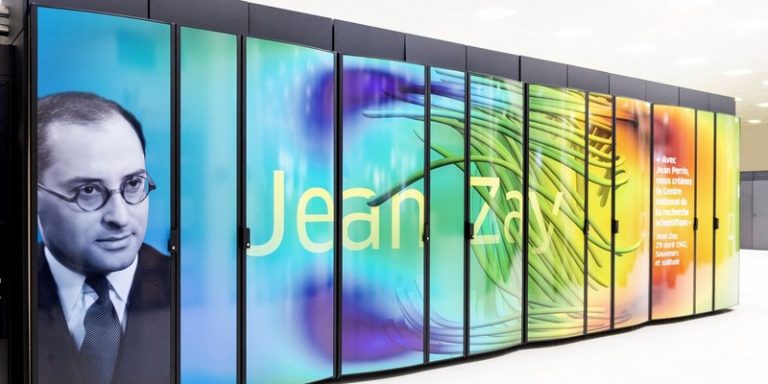
The Jean Zay supercomputer is at the heart of several cutting-edge research projects such as Big Science. It has become an essential tool, and ActuIA has also devoted a feature to it in the next issue of the magazine, due out in a few days. Last month, GENCI, the French national agency in charge of high-performance computing and storage resources for academic and industrial research, the CNRS via IDRIS (Institut du Développement et des Ressources en Informatique Scientifique), Hewlett PackardEnterprise (HPE) and NVIDIA announced a massive increase in its resources dedicated to artificial intelligence research. Here’s a look back at this announcement, which will enable the organization to meet the growing demand.
The Jean Zay supercomputer is a giant. Physically, it occupies a floor space of 150 m2, weighs 43 tonnes and consumes almost 2 MWh of electricity. It is the first French supercomputer converged between HPC and AI, resulting from the national plan “AIForHumanity” of March 2018. GENCI (Grand Equipement National de Calcul Intensif) makes it available to French and European AI researchers, who thus benefit from its high-performance computing.
Commissioned at the end of 2019, Jean Zay is one of the most powerful converged supercomputers in Europe. It has a hierarchical organization on several levels that allow it to support a very large load of data access. It is free to use for open research in HPC and AI. More than 700 academic or industrial research projects (from startups, SMEs and large companies) using AI methods have benefited from its resources.
The projects it has enabled have focused on a wide range of fields: smart cities, health and medicine (e.g. the fight against Covid-19 and cancer), neuroscience, robotics, social sciences, chemistry, particle physics, astrophysics, climatology, automatic language processing, computer vision, etc.
Nine AI experts from CNRS and INRIA have joined the IDRIS application support team, which now numbers 21 people.
Increased resources at Jean Zay
Jean Zay will see its configuration evolve further to reach a total of more than 3,152 GPUs by the beginning of 2022, including both NVIDIA V100 GPUs and NVIDIA A100 Tensor Core GPUs. The power of the former is expected to double the current computing capacity dedicated to Artificial Intelligence on Jean Zay.
The extension will feature 52 HPE Apollo 6500 Gen 10 servers, each with 8 NVIDIA A100s (a total of 640GB of HBM2 memory per server), which are particularly well suited to large-scale AI or vision models.
The deployment of this new computing capacity will enable the development of innovative, world-class research projects such as BigScience and COVID_19.L
IDRIS and the Établissement public d’aménagement Paris-Saclay (EPAPS) are planning to recycle the heat produced by the Jean Zay supercomputer to supply the heat and cold exchange network of the Paris-Saclay urban campus, providing thermal coverage equivalent to 1,000 homes.
Philippe Lavocat, Chairman and CEO of GENCI, said:
“The Jean Zay extension strengthens France’s position among the leading countries in academic and industrial research in artificial intelligence. This is one of GENCI’s key missions, in line with its strategic plan. This is a testament to the Jean Zay supercomputer in the scientific community and the relevance of the response to its AI needs.”
According to Antoine Petit, Chairman and CEO of CNRS:
“Artificial intelligence and its applications
applications are one of the CNRS priorities described in its contract of objectives and performance (2019-2023). The reinforcement of the computing resources of Jean Zay, hosted
and operated by IDRIS, the CNRS’s national high-performance computing center, is essential to meet the many challenges emerging in the French research communities, including those of the CNRS.
including those of the CNRS. CNRS is making significant efforts to provide the best possible environment for IDRIS and the best possible support for users.
Renaud Vedel, Coordinator of the National Strategy for AI:
“On the recommendation of the Villani report, the French strategy for AI has placed equal access to supercomputers as key. All researchers who publish according to the rules of open science, from public laboratories but also from private teams and especially startups, can benefit from this, with the added support of application support teams. And we can see today that this double bet
accelerates the diffusion of AI in all scientific disciplines and technological fields and offers
technological fields and offers them new discovery tools. We are pleased to accompany GENCI and IDRIS, who have successfully committed themselves, in this new expansion.”
Translated from Pourquoi le supercalculateur Jean Zay connait une augmentation de ses performances en intelligence artificielle









